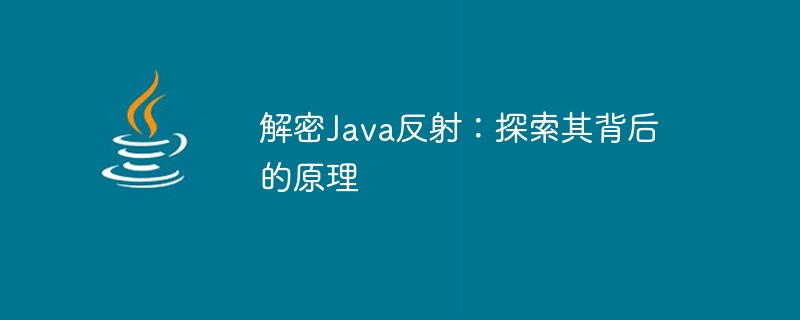

Decrypting Java Reflection: To explore the principles behind it, specific code examples are required
Introduction:
In Java programming, reflection (Reflection) is a powerful And the flexible mechanism allows us to dynamically check classes, interfaces, fields and methods at runtime, and even call and operate them without knowing the specific class. This article will delve into the principles behind Java reflection and provide specific code examples to help readers better understand and apply reflection.
What is reflection?
In short, reflection is a mechanism for obtaining and manipulating class information at runtime. It enables us to achieve the following functions:
Java reflection principle:
The principle of Java reflection is based on Java's class loading mechanism. In Java, when a class is used for the first time, it will be loaded into memory by the Java Virtual Machine (JVM) and a corresponding Class object will be created by the system. Reflection can obtain any information about the class through this Class object, such as the class name, parent class, interface, fields, methods, etc.
Specific code examples:
The following examples demonstrate the process of using reflection to dynamically create objects, access fields, and call methods.
import java.lang.reflect.Field;
import java.lang.reflect.Method;
public class ReflectionExample {
public static void main(String[] args) throws Exception {
// 获取类的Class对象
Class<?> clazz = Class.forName("com.example.Person");
// 创建对象
Object person = clazz.getDeclaredConstructor().newInstance();
// 获取字段并设置值
Field nameField = clazz.getDeclaredField("name");
nameField.setAccessible(true);
nameField.set(person, "John");
// 调用方法
Method greetingMethod = clazz.getDeclaredMethod("greeting");
greetingMethod.setAccessible(true);
greetingMethod.invoke(person);
}
}
class Person {
private String name;
public void greeting() {
System.out.println("Hello, my name is " + name);
}
}In the above example, the Class object of the Person class is first obtained through the Class.forName method. Then, a Person object is dynamically created using reflection. Next, the name field of the Person class is obtained through the getField method, and a value is set using the set method. Finally, the greeting method of the Person class is obtained through the getMethod method, and the method is called through the invoke method.
Application scenarios and precautions:
The reflection mechanism is widely used in Java. For example, dependency injection, dynamic proxy and other technologies in the Spring framework are all based on reflection. However, it should be noted that since reflection is a relatively low-level operation, excessive use of reflection may lead to performance degradation and is not intuitive and easy to understand. Therefore, when using reflection, you should weigh its advantages and disadvantages and choose the appropriate method of use.
Conclusion:
Through the analysis of the principles and code examples of Java reflection, we understand the basic concepts and usage of the reflection mechanism. Reflection provides us with a flexible and powerful way to inspect and manipulate the properties and methods of a class. But when using it, we need to use it carefully according to the specific situation, and pay attention to the performance impact of reflection to ensure the elegance and efficiency of the code.
The above is the detailed content of Demystifying Java Reflection: Exploring the Deep Mysteries of How It Works. For more information, please follow other related articles on the PHP Chinese website!
